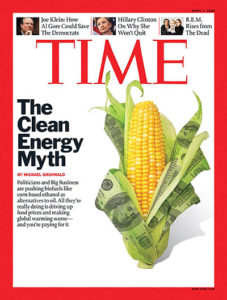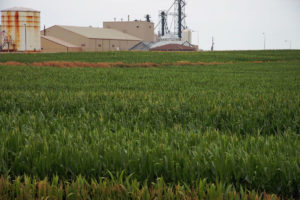Direct Attack from Indirect Land Use
After enjoying several years of relatively positive media attention, the ethanol industry found itself increasingly on the defensive in 2008 and even environmentalists began to turn on the clean fuel alternative. In addition to the food versus fuel narrative, early in the year there were a pair of studies published alleging that biofuels production would cause Indirect Land Use Change (ILUC) “as farmers worldwide respond to higher prices and convert forest and grassland to new cropland to replace the grain (or cropland) diverted to biofuels.”
“Use of U.S. Croplands for Biofuels Increases Greenhouse Gases Through Emissions from Land-Use Change” was led by Timothy Searchinger, Princeton University.
“By using a worldwide agricultural model to estimate emissions from land-use change, we found that corn-based ethanol, instead of producing a 20% savings, nearly doubles greenhouse emissions over 30 years and increases greenhouse gases for 167 years,” was the conclusion of Searchinger et al. “Biofuels from switchgrass, if grown on U.S. corn lands, increase emissions by 50%.”
Joseph Fargione with the University of Minnesota co-authored “Land clearing and the biofuel carbon debt.”
Converting rainforests, peatlands, savannas, or grasslands to produce food crop-based biofuels in Brazil, Southeast Asia, and the United States creates a “biofuel carbon debt” by releasing 17 to 420 times more CO2 than the annual greenhouse gas (GHG) reductions that these biofuels would provide by displacing fossil fuels. In contrast, biofuels made from waste biomass or from biomass grown on degraded and abandoned agricultural lands planted with perennials incur little or no carbon debt and can offer immediate and sustained GHG advantages.
The ethanol industry and government environmental sources immediately worked to debunk the studies, but the damage it caused to the clean reputation of ethanol was a main stream media story.
Dr. Michael Wang of Argonne’s Transportation Technology R&D Center and Zia Haq of the DOE’s Office of Biomass Program argued that the study authors “used the GREET model developed by one of us at Argonne National Laboratory in their study.” However, the model uses outdated data and the study authors used a worst-case scenario approach.
Searchinger et al. modeled a case in which U.S. corn ethanol production increased from 15 billion gallons a year to 30 billion gallons a year by 2015. However, in the 2007 Energy Independence and Security Act (EISA), Congress established an annual corn ethanol production cap of 15 billion gallons by 2015. Congress established the cap — based on its awareness of the resource limitations for corn ethanol production — to help prevent dramatic land use changes. Thus, Searchinger et al. examined a corn ethanol production case that is not directly relevant to U.S. corn ethanol production in the next seven years.
Wang and Haq concluded, “While scientific assessment of land use change issues is urgently needed in order to design policies that prevent unintended consequences from biofuel production, conclusions regarding the GHG emissions effects of biofuels based on speculative, limited land use change modeling may misguide biofuel policy development.”
 Newly confirmed Secretary of Agriculture Ed Schafer addressed the issue during an appearance at the 2008 Commodity Classic in Nashville.
Newly confirmed Secretary of Agriculture Ed Schafer addressed the issue during an appearance at the 2008 Commodity Classic in Nashville.
Asked if there was any chance that there might be a delay in implementing the new Renewable Fuel Standard because of recent reports claiming that biofuels are bad for the environment, Schafer said no.
“I don’t because no matter what happens it’s not going to have an effect this year,” Schafer said. “We are getting to the point of topping out on ethanol production, not because of production capacity, but because of our ability to deliver it in the current infrastructure.”
“The research dollars are going in to move from ethanol to the cellulosic generation,” Schafer continued. “While we are playing catch up on non-price distorting feedstocks for ethanol, which is going to take some time, we do think we are arriving at the levels this year where we are going to see a leveling off of (commodity) prices.”
 The Time Magazine cover story in April was brutal, blaming biofuels production for deforestation of the Amazon rainforest and comparing it to “witnessing a rape.”
The Time Magazine cover story in April was brutal, blaming biofuels production for deforestation of the Amazon rainforest and comparing it to “witnessing a rape.”
Time’s Michael Grunwald claimed:
… most of the damage created by biofuels will be less direct and less obvious. In Brazil, for instance, only a tiny portion of the Amazon is being torn down to grow the sugarcane that fuels most Brazilian cars. More deforestation results from a chain reaction so vast it’s subtle: U.S. farmers are selling one-fifth of their corn to ethanol production, so U.S. soybean farmers are switching to corn, so Brazilian soybean farmers are expanding into cattle pastures, so Brazilian cattlemen are displaced to the Amazon. It’s the remorseless economics of commodities markets. “The price of soybeans goes up,” laments Sandro Menezes, a biologist with Conservation International in Brazil, “and the forest comes down.”
New Ethanol Promotion and Information Council (EPIC) Executive Director Toni Nuernberg sent a letter to the editor of Time in an effort to provide the other side of the story.
Grunwald fails to consult experts in the field of biofuels lifecycle analysis, such as Dr. Bruce Dale of Michigan State and Dr. Michael Wang of the U.S. Department of Energy’s (DOE) Argonne National Laboratory. Both experts agree that the studies by Searchinger and Fargione raise important issues. However, they question many of the assumptions made by Searchinger and Fargione, and term them “highly speculative and uncertain scenarios for what might happen as a result of increased demand for corn grain.”
 By the end of the year, the Renewable Fuels Association had generated a study showing the amount of agricultural land required to produce 15 billion gallons of grain ethanol in the United States by 2015, as required by the 2007 Energy Independence and Security Act (EISA), is likely to be less than 1 percent of total world cropland.
By the end of the year, the Renewable Fuels Association had generated a study showing the amount of agricultural land required to produce 15 billion gallons of grain ethanol in the United States by 2015, as required by the 2007 Energy Independence and Security Act (EISA), is likely to be less than 1 percent of total world cropland.
According to the report, “Understanding Land Use Change and U.S. Ethanol Expansion,” gains in agricultural productivity, coupled with the contribution of feed produced as an ethanol co-product, are expected to significantly mitigate the need for conversion of non-agricultural lands to support expanded U.S. biofuels production.
Moreover, there is no empirical evidence demonstrating land conversion abroad is a result of U.S. biofuels production. “Unfortunately, the current state of land use change science is far from conclusive and no consensus exists on how best to analyze the potential indirect land use impacts of expanding biofuels production,” continued the report.
ILUC would become a bigger issue in 2009 while food versus fuel was the misinformation dragon the industry was trying to slay in 2008.
Ethanol Industry Bites Back at Food vs. FuelThe chorus of voices blaming biofuels for high food prices that started in 2007 got much louder in 2008 as the Washington Post in April headlined a Global Food Crisis.
This series explores the causes and effects of the world’s worst food crisis since the 1970s. A complex combination of poor harvests, competition with biofuels, higher energy prices, surging demand in China and India, and a blockage in global trade is driving food prices up worldwide. Some countries, especially in Africa, are facing an increasingly dire situation while even consumers in wealthy nations are being forced to adjust.
As the fourth part of the series was published, the industry gathered at the National Press Club to fight the misinformation with facts, sending RFA president and CEO Bob Dinneen, National Corn Growers Association CEO Rick Tolman, National Farmers Union president Tom Buis, and former Secretary of Agriculture John Block into the ring.
Tolman called the Washington Post series the “classic PR strategy of turning a little Bo peep into the axe murderer…where there’s a lot of misinformation, slanted information, that’s just inaccurate…I think while we do have some role in higher food prices in the corn industry, we’re certainly closer to little Bo peep than we are the axe murderer.”
Tolman then proceeded to give a Corn Ethanol 101 course to the media, starting with the simple fact that corn for ethanol is not sweet corn for human consumption, explaining the economics of increasing corn yields and decreasing corn prices, and unmasking the real villain behind higher prices.
“It takes 10 ounces of corn to produce a box of corn flakes that sells for over $3. There’s 3.3 cents in that box of corn flakes of corn at $3. When it goes up to $4.00, it goes to $0.04 worth of corn. So at the retail level, higher corn prices at the farm gate have very little impact on retail food prices,” said Tolman. “If you want to know who the real axe murderer is, look at $4.00 a gallon gasoline. Look at $120.00 a barrel oil.”

L-R: Former USDA Secretary John Block, RFA CEO Bob Dinneen, NFU president Tom Buis, NCGA CEO Rick Tolman
Block admitted that biofuels have had a small impact on food prices but weather issues and the high price of oil have a much greater impact. “So it’s unreasonable to blame biofuels for a big part of this especially internationally, because we are not shorting the market on grain, we are exporting more grain than we ever have in history.”
Dinneen and Buis also defended corn and ethanol against the accusations and criticism and called it a “well-organized campaign” to cut the legs off the industry just as it was finally starting to gain a foothold in the nation’s liquid fuel supply.
Big Food Fights Dirty Against Ethanol
 The following month, the anti-ethanol agenda was exposed by one of the nation’s biggest ethanol supporters.
The following month, the anti-ethanol agenda was exposed by one of the nation’s biggest ethanol supporters.
Ethanol proponents from the halls of Congress to the corn fields of the Midwest are expressing outrage at documentation that major food corporations may have supported a high-dollar public relations campaign to blame farmers and ethanol for rising food prices.
In a prepared floor statement on Thursday, Senator Chuck Grassley of Iowa told his colleagues that “this anti-ethanol campaign is not a coincidence. It turns out that a $300,000, six-month retainer of a beltway public relations firm is behind the smear campaign, hired by the Grocery Manufacturers Association.”
A report in Roll Call revealed that GMA had retained the services of Glover Park Group specifically for the purpose of rolling back the ethanol mandates that passed in the energy bill.
Among the documents obtained by Roll Call was the GMA’s proposal request “to build a groundswell in support of freezing or reversing some provisions of the 2007 Energy Bill and for the elimination/reform of ethanol subsidies and import restrictions.”
Glover Park Group’s proposal response included the number one objective to “obliterate whatever intellectual justification might still exist for corn-based ethanol among policy elites.”
(Ironically, the ethanol industry would sign the same agency four years later to help with its efforts to defend the RFS.)
 Agriculture Secretary Ed Schafer addressed the issue in a press conference, saying he had talked to the people who have “initiated these underground things that have been going on” to influence public opinion about ethanol incentives and found that while they understand that higher energy and transportation costs are the driving factor for increased food prices, they think “it’s easier” to target corn and ethanol.
Agriculture Secretary Ed Schafer addressed the issue in a press conference, saying he had talked to the people who have “initiated these underground things that have been going on” to influence public opinion about ethanol incentives and found that while they understand that higher energy and transportation costs are the driving factor for increased food prices, they think “it’s easier” to target corn and ethanol.
“The change in the Renewable Fuel Standard, the change in the (ethanol) tariff or duty, isn’t going to effect food prices,” Schafer said. “We need to focus on things that will actually have an effect, instead of a short-term political solution we need to look long-term, because we have a long-term problem here.”
Texas Governor Fights for Waiver
 Texas Governor Rick Perry filed the first of many waiver requests in 2008 in his fight against the Renewable Fuel Standard, claiming the use of corn for ethanol had resulted in “skyrocketing” food prices.
Texas Governor Rick Perry filed the first of many waiver requests in 2008 in his fight against the Renewable Fuel Standard, claiming the use of corn for ethanol had resulted in “skyrocketing” food prices.
Perry requested a 50% waiver of the RFS as “the best, quickest way” to ease rising food costs before lasting damage was done.
The ethanol industry vigorously challenged the request, saying it could increase fuel prices even more. “Tampering, adjusting or removing the requirements will not have the impact on grain prices that Governor Perry seeks, nor will it bring the food price reductions he claims,” said RFA President Bob Dinneen. “The skyrocketing price of oil, surging global demand for grains and meat, poor harvests around the globe, and a weakened US dollar are the real factors determining world grain and food prices.”
Ultimately EPA denied the request, finding adequate feedstocks available to meet the 9-billion-gallon RFS for 2008, so “a waiver would have no impact on ethanol production volumes in the relevant time frame, and therefore no impact on corn, food, or fuel prices.”
Food and Fuel at World Food Prize
“I think there’s a moral challenge in utilizing food for fuel at a time when there’s so many hungry people in the world,” said McGovern. “On the other hand, if it’s kept within reasonable bounds, I think it can be good both for agriculture and for nutrition. I’m told by the researchers that in addition to corn there are various forms of grass that can produce ethanol.”
Dole said when it comes to energy, the answer lies in having a number of alternatives. “Switchgrass, and there are there other biofuels and there’s nuclear energy and there’s drilling offshore. I’m not an expert on energy, but I know we’ve got to do everything we can to find alternatives and it’s not all going to be ethanol.”


